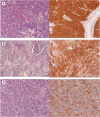Pediatric medulloblastoma - update on molecular classification driving targeted therapies
- PMID: 25101241
- PMCID: PMC4105823
- DOI: 10.3389/fonc.2014.00176
Pediatric medulloblastoma - update on molecular classification driving targeted therapies
Abstract
As advances in the molecular and genetic profiling of pediatric medulloblastoma evolve, associations with prognosis and treatment are found (prognostic and predictive biomarkers) and research is directed at molecular therapies. Medulloblastoma typically affects young patients, where the implications of any treatment on the developing brain must be carefully considered. The aim of this article is to provide a clear comprehensible update on the role molecular profiling and subgroups in pediatric medulloblastoma as it is likely to contribute significantly toward prognostication. Knowledge of this classification is of particular interest because there are new molecular therapies targeting the Shh subgroup of medulloblastomas.
Keywords: classification; medulloblastoma; molecular; pediatric; therapies.
Figures





References
Publication types
LinkOut - more resources
Full Text Sources
Other Literature Sources
Research Materials

